Antimicrobial Plastics Market Size
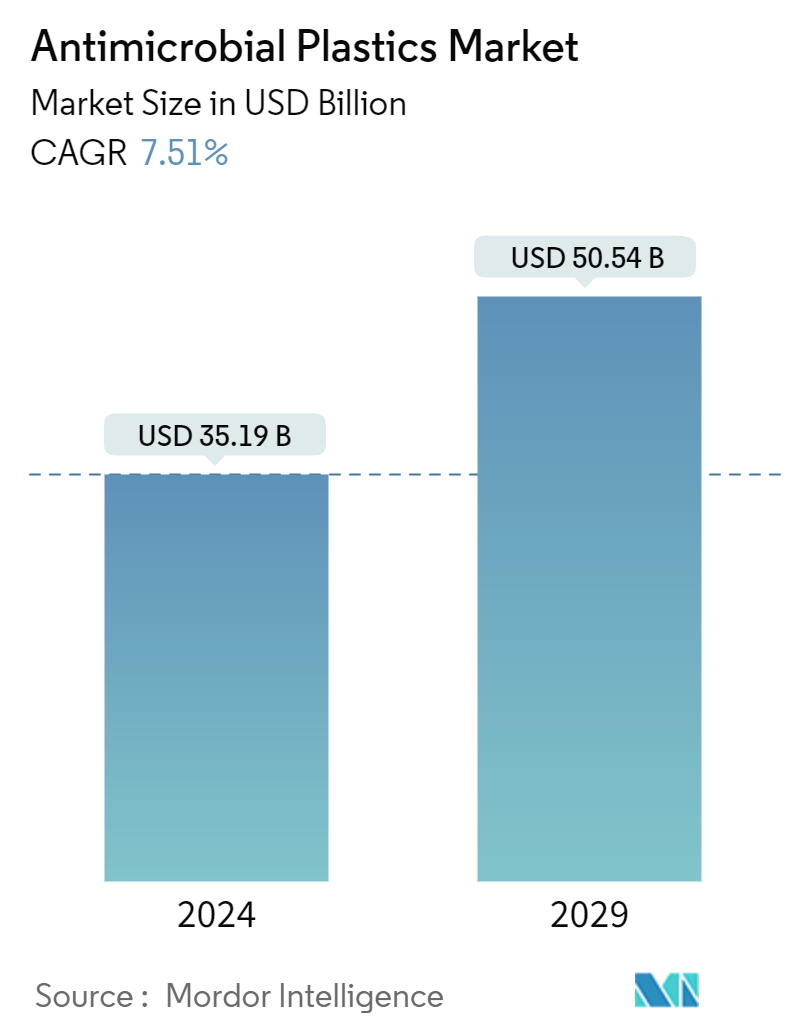
| Study Period | 2019 - 2029 |
| Market Size (2024) | USD 35.19 Billion |
| Market Size (2029) | USD 50.54 Billion |
| CAGR (2024 - 2029) | 7.51 % |
| Fastest Growing Market | Asia Pacific |
| Largest Market | Asia Pacific |
Major Players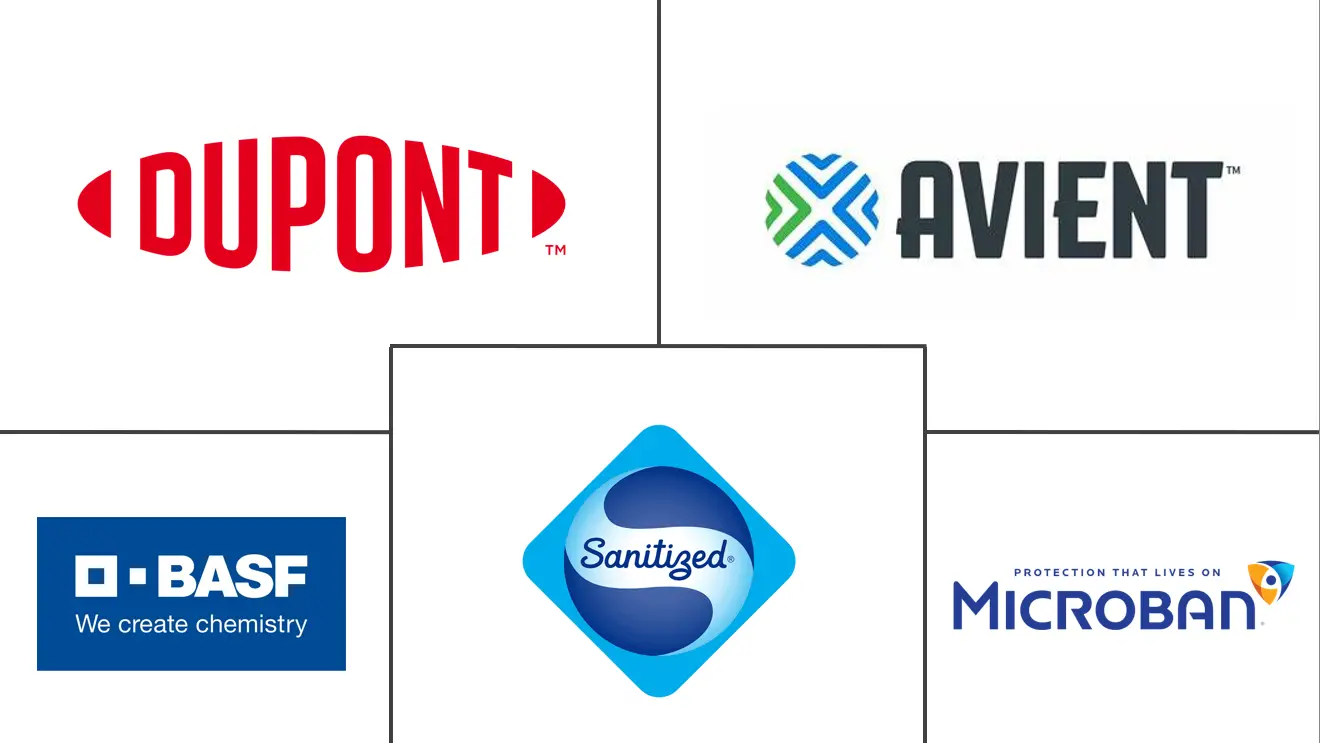
*Disclaimer: Major Players sorted in no particular order |
Antimicrobial Plastics Market Analysis
The Antimicrobial Plastics Market size is estimated at USD 35.19 billion in 2024, and is expected to reach USD 50.54 billion by 2029, growing at a CAGR of 7.51% during the forecast period (2024-2029).
The antimicrobial plastics market is gaining significant traction due to the rising demand for safer, more hygienic materials across various industries. These plastics, enhanced with antimicrobial additives , provide superior protection against microbial contamination. As sectors like healthcare, food packaging, and consumer goods increasingly prioritize hygiene and safety, the relevance and application of antimicrobial plastics are expanding rapidly, with the market poised for significant growth.
Growth Drivers in the Antimicrobial Plastics Market
- Material Substitution: The shift from conventional materials to antimicrobial plastics is a key growth driver. These plastics offer a combination of durability and the ability to inhibit the growth of harmful microorganisms, making them a preferred choice across industries. This trend is expected to continue as hygiene concerns grow globally, particularly in the wake of recent health crises, boosting the demand for antimicrobial plastic products.
- Healthcare and Packaging Demand: The healthcare and packaging industries are driving demand for antimicrobial plastics. In healthcare, these materials are crucial for reducing infection risks in medical devices, equipment, and surfaces. Similarly, in the packaging industry, especially for food and beverages, antimicrobial plastics help extend shelf life and maintain product safety. This demand is bolstered by increasing consumer awareness and the regulatory push for safer packaging solutions.
Challenges and Opportunities
- Environmental Regulations: Stringent environmental regulations pose a significant challenge to the antimicrobial plastics market. The production and disposal of these plastics are under scrutiny due to their environmental impact. Manufacturers are compelled to innovate, developing sustainable antimicrobial plastic solutions that comply with rigorous environmental standards. This challenge is particularly pronounced in regions with stringent regulations, where compliance can influence market dynamics.
- Raw Material Price Volatility: The antimicrobial plastics market faces the challenge of fluctuating raw material prices. These fluctuations, driven by supply chain disruptions, geopolitical tensions, and global demand shifts, can increase production costs and impact pricing strategies. This volatility introduces pricing pressures that could affect market growth and profitability, making it a critical factor for industry stakeholders to manage.
Antimicrobial Plastics Market Trends
Healthcare Industry Driving the Market Demand
The healthcare sector is the largest consumer of antimicrobial plastics, driven by the need to mitigate healthcare-associated infections (HAIs). The integration of antimicrobial plastic additives in medical devices, surgical tools, and hospital environments is essential for ensuring safer conditions for patients and healthcare professionals alike. Technological advancements in antimicrobial polymers and coatings are further enhancing their effectiveness, making these materials indispensable in healthcare settings.
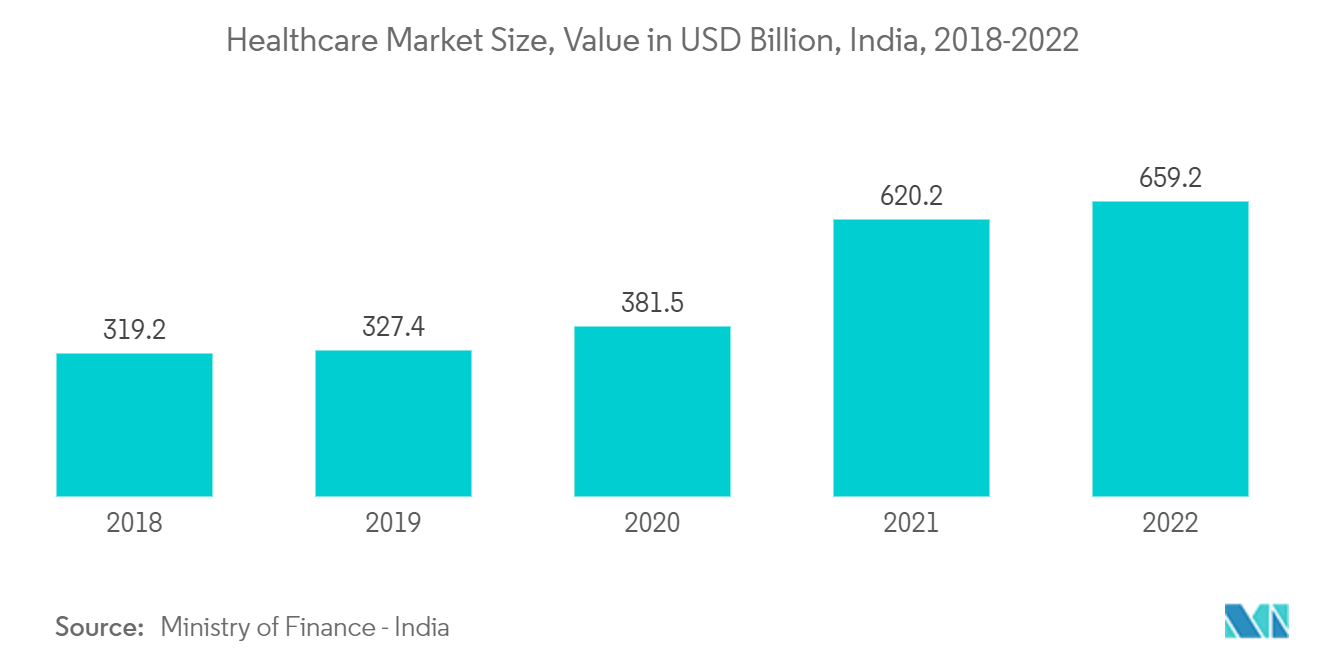
Asia-Pacific to Dominate the Market
The Asia-Pacific region is expected to lead the antimicrobial plastics market due to rapid industrialization, urbanization, and a growing consumer base. Countries like China, India, and Japan are at the forefront of this growth, particularly in the healthcare, packaging, and consumer goods sectors. The region's robust manufacturing base, coupled with increasing consumer awareness of health and hygiene, is driving demand for antimicrobial plastic applications.
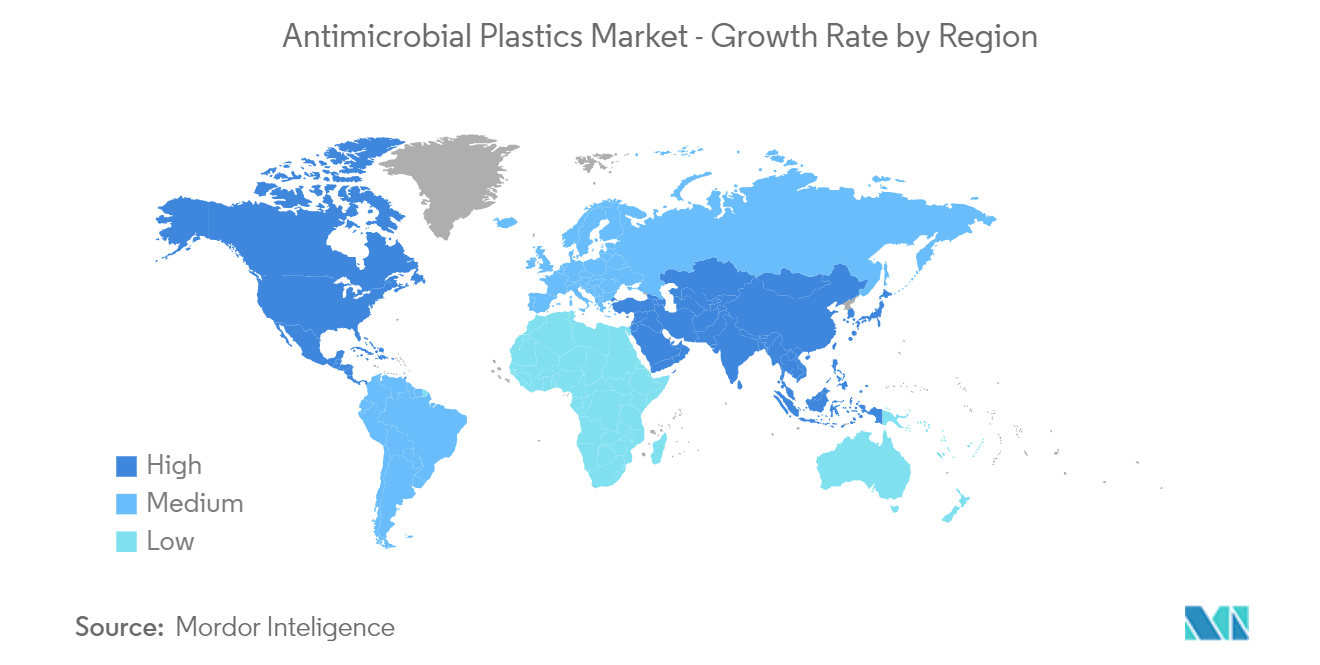
Antimicrobial Plastics Industry Overview
- Moderate Market Consolidation: The antimicrobial plastics market is moderately consolidated, with global giants like BASF SE, DuPont, and Microban International dominating. These companies leverage their extensive R&D capabilities and global distribution networks to maintain significant market shares. However, the presence of mid-sized companies and niche players also contributes to a competitive environment, driving innovation and market growth.
- Innovation and Sustainability: For companies to succeed in the antimicrobial plastics market, continuous innovation, regulatory compliance, and sustainability are key. Developing new antimicrobial formulations that meet environmental standards is crucial for maintaining a competitive edge. Additionally, expanding into emerging markets and focusing on high-growth applications like medical devices and food packaging will be essential for future success.
- The antimicrobial plastics market is poised for ongoing evolution as industries continue to prioritize hygiene and safety. Despite challenges such as stringent environmental regulations and raw material price volatility, the market is expected to expand, driven by the critical role these materials play in healthcare, packaging, and other key sectors.
Antimicrobial Plastics Market Leaders
-
BASF SE
-
DuPont
-
Microban International
-
Sanitized AG
-
Avient Corporation
*Disclaimer: Major Players sorted in no particular order
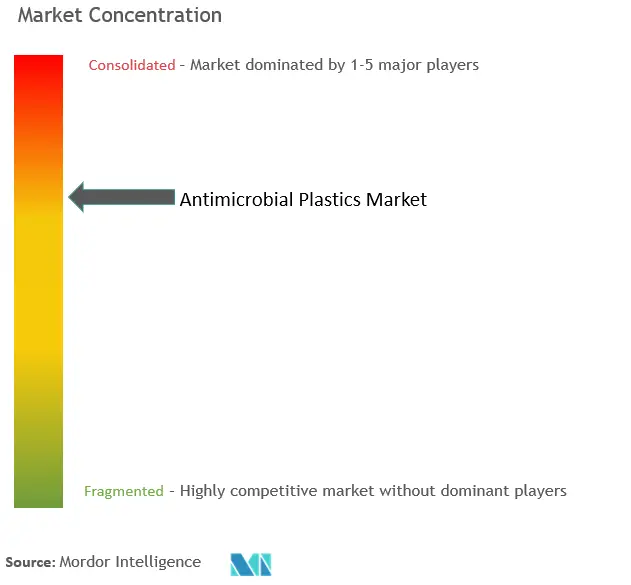
Antimicrobial Plastics Market News
April 2023: Symphony Environmental Technologies invented a ground-breaking and scientifically proven d2w additive technology that makes plastics 100% biodegradable. Symphony’s d2w additive can be used in plastics manufacturing to convert end-of-life plastics to nothing more than a soil component that is naturally bio-assimilated by bacteria and fungi.
February 2023: Microban International has launched a series of antimicrobial functions by introducing Microguard technology. This technology aims to bring antifungal properties to PVC, PU, and EVA plastics by preventing degradation and extending the product's life span.
Antimicrobial Plastics Market Report - Table of Contents
1. INTRODUCTION
- 1.1 Study Deliverables
- 1.2 Study Assumptions
- 1.3 Scope of the Study
2. RESEARCH METHODOLOGY
3. EXECUTIVE SUMMARY
4. MARKET DYNAMICS
-
4.1 Drivers
- 4.1.1 Replacement of Conventional Materials by Plastics in Various Applications
- 4.1.2 Rapidly Increasing Demand from the Healthcare and Packaging Industries
- 4.1.3 Growing Consciousness of Antimicrobial Plastics
-
4.2 Restraints
- 4.2.1 Stringent Environmental Regulations
- 4.2.2 Erratic Fluctuations in Raw Material Prices
- 4.3 Industry Value Chain Analysis
-
4.4 Porter's Five Forces Analysis
- 4.4.1 Bargaining Power of Suppliers
- 4.4.2 Bargaining Power of Buyers
- 4.4.3 Threat of New Entrants
- 4.4.4 Threat of Substitute Products and Services
- 4.4.5 Degree of Competition
5. MARKET SEGMENTATION (Market Size in Value)
-
5.1 Type
- 5.1.1 Commodity Plastic
- 5.1.2 Engineering Plastic
- 5.1.3 High Performance Plastic
- 5.1.4 Other Types (Bioplastics, etc.)
-
5.2 End-User Industry
- 5.2.1 Automotive
- 5.2.2 Building and Construction
- 5.2.3 Consumer Goods
- 5.2.4 Electrical and Electronics
- 5.2.5 Food and Beverage
- 5.2.6 Healthcare
- 5.2.7 Packaging
- 5.2.8 Other End-user Industries (Textile, etc.)
-
5.3 Geography
- 5.3.1 Asia-Pacific
- 5.3.1.1 China
- 5.3.1.2 India
- 5.3.1.3 Japan
- 5.3.1.4 South Korea
- 5.3.1.5 Rest of Asia-Pacific
- 5.3.2 North America
- 5.3.2.1 United States
- 5.3.2.2 Canada
- 5.3.2.3 Mexico
- 5.3.3 Europe
- 5.3.3.1 Germany
- 5.3.3.2 United Kingdom
- 5.3.3.3 France
- 5.3.3.4 Italy
- 5.3.3.5 Rest of Europe
- 5.3.4 South America
- 5.3.4.1 Brazil
- 5.3.4.2 Argentina
- 5.3.4.3 Rest of South America
- 5.3.5 Middle East and Africa
- 5.3.5.1 Saudi Arabia
- 5.3.5.2 South Africa
- 5.3.5.3 Rest of Middle East and Africa
6. COMPETITIVE LANDSCAPE
- 6.1 Mergers and Acquisitions, Joint Ventures, Collaborations, and Agreements
- 6.2 Market Share (%)**/Ranking Analysis
- 6.3 Strategies Adopted by Leading Players
-
6.4 Company Profiles
- 6.4.1 Avient Corporation
- 6.4.2 BASF SE
- 6.4.3 Bayer AG
- 6.4.4 BioCote Limited
- 6.4.5 CLARIANT
- 6.4.6 Covestro AG
- 6.4.7 DuPont
- 6.4.8 King Plastic Corporation
- 6.4.9 Lonza
- 6.4.10 Microban International
- 6.4.11 Milliken & Company
- 6.4.12 Parx Materials NV
- 6.4.13 Sanitized AG
- 6.4.14 Symphony Environmental Technologies
- *List Not Exhaustive
7. MARKET OPPORTUNITIES AND FUTURE TRENDS
- 7.1 Increasing Investments in Research and Development
- 7.2 Increasing Investments in Healthcare Sector
Antimicrobial Plastics Industry Segmentation
Antimicrobial Plastics are polymers infused with agents capable of eradicating or restraining the proliferation of microorganisms like bacteria, viruses, and fungi. These antimicrobial compounds are typically incorporated into the plastic during its manufacturing, allowing for tailor-made and enduring antimicrobial defense. Such plastics find widespread use across diverse sectors, including medical devices, food packaging, and water treatment systems.
Type, end-user industry, and geography segment the antimicrobial plastics market. By type, the market is segmented into commodity plastic, engineering plastic, high-performance plastic, and other types (bioplastics, etc.). By end-user industry, the market is segmented into packaging, healthcare, consumer goods, electrical and electronics, automotive, building and construction, food and beverage, and others (textile, etc.). The report also covers the market size and forecasts for the antimicrobial plastics market in 15 countries across major regions. Each segment's market sizing and forecasts are provided on the basis of value (USD).
| Type | Commodity Plastic | |
| Engineering Plastic | ||
| High Performance Plastic | ||
| Other Types (Bioplastics, etc.) | ||
| End-User Industry | Automotive | |
| Building and Construction | ||
| Consumer Goods | ||
| Electrical and Electronics | ||
| Food and Beverage | ||
| Healthcare | ||
| Packaging | ||
| Other End-user Industries (Textile, etc.) | ||
| Geography | Asia-Pacific | China |
| India | ||
| Japan | ||
| South Korea | ||
| Rest of Asia-Pacific | ||
| Geography | North America | United States |
| Canada | ||
| Mexico | ||
| Geography | Europe | Germany |
| United Kingdom | ||
| France | ||
| Italy | ||
| Rest of Europe | ||
| Geography | South America | Brazil |
| Argentina | ||
| Rest of South America | ||
| Geography | Middle East and Africa | Saudi Arabia |
| South Africa | ||
| Rest of Middle East and Africa |
Antimicrobial Plastics Market Research FAQs
How big is the Antimicrobial Plastics Market?
The Antimicrobial Plastics Market size is expected to reach USD 35.19 billion in 2024 and grow at a CAGR of 7.51% to reach USD 50.54 billion by 2029.
What is the current Antimicrobial Plastics Market size?
In 2024, the Antimicrobial Plastics Market size is expected to reach USD 35.19 billion.
Who are the key players in Antimicrobial Plastics Market?
BASF SE, DuPont, Microban International, Sanitized AG and Avient Corporation are the major companies operating in the Antimicrobial Plastics Market.
Which is the fastest growing region in Antimicrobial Plastics Market?
Asia Pacific is estimated to grow at the highest CAGR over the forecast period (2024-2029).
Which region has the biggest share in Antimicrobial Plastics Market?
In 2024, the Asia Pacific accounts for the largest market share in Antimicrobial Plastics Market.
What years does this Antimicrobial Plastics Market cover, and what was the market size in 2023?
In 2023, the Antimicrobial Plastics Market size was estimated at USD 32.55 billion. The report covers the Antimicrobial Plastics Market historical market size for years: 2019, 2020, 2021, 2022 and 2023. The report also forecasts the Antimicrobial Plastics Market size for years: 2024, 2025, 2026, 2027, 2028 and 2029.
Antimicrobial Plastic Industry Report
Our in-depth industry research on the antimicrobial plastics market provides comprehensive insights into the rapidly evolving landscape, where the demand for safer, more hygienic materials is driving significant growth. The report delves into key areas, including market segmentation, antimicrobial plastic applications, and technological advancements in antimicrobial plastic technology. Our analysis offers valuable industry information, highlighting how antimicrobial plastic additives and biocidal plastics are shaping market trends. With a strong focus on industry growth and market forecast, stakeholders will benefit from understanding the factors influencing the antimicrobial plastic market size and the dynamics driving antimicrobial plastic demand. All insights are compiled in an easy-to-access report pdf format, ensuring decision-makers have the critical data they need.
This industry report also explores the competitive landscape, examining the strategies of market leaders and emerging players alike. We provide a detailed market overview, covering antimicrobial packaging materials and the innovative approaches adopted by antimicrobial plastic suppliers to comply with environmental regulations. The report also addresses the challenges posed by raw material price volatility and the impact of sustainability trends on the antimicrobial plastic industry. By offering a clear market outlook and thorough industry analysis, this report equips stakeholders with the industry statistics and market data necessary to navigate the antimicrobial plastic market's future landscape successfully.
Statistics for the 2024 Antimicrobial Plastics market share, size and revenue growth rate, created by Mordor Intelligence™ Industry Reports. Antimicrobial Plastics analysis includes a market forecast outlook to for 2024 to 2029 and historical overview. Get a sample of this industry analysis as a free report PDF download.



